Udenrigsudvalget 2013-14
URU Alm.del Bilag 174
Offentligt


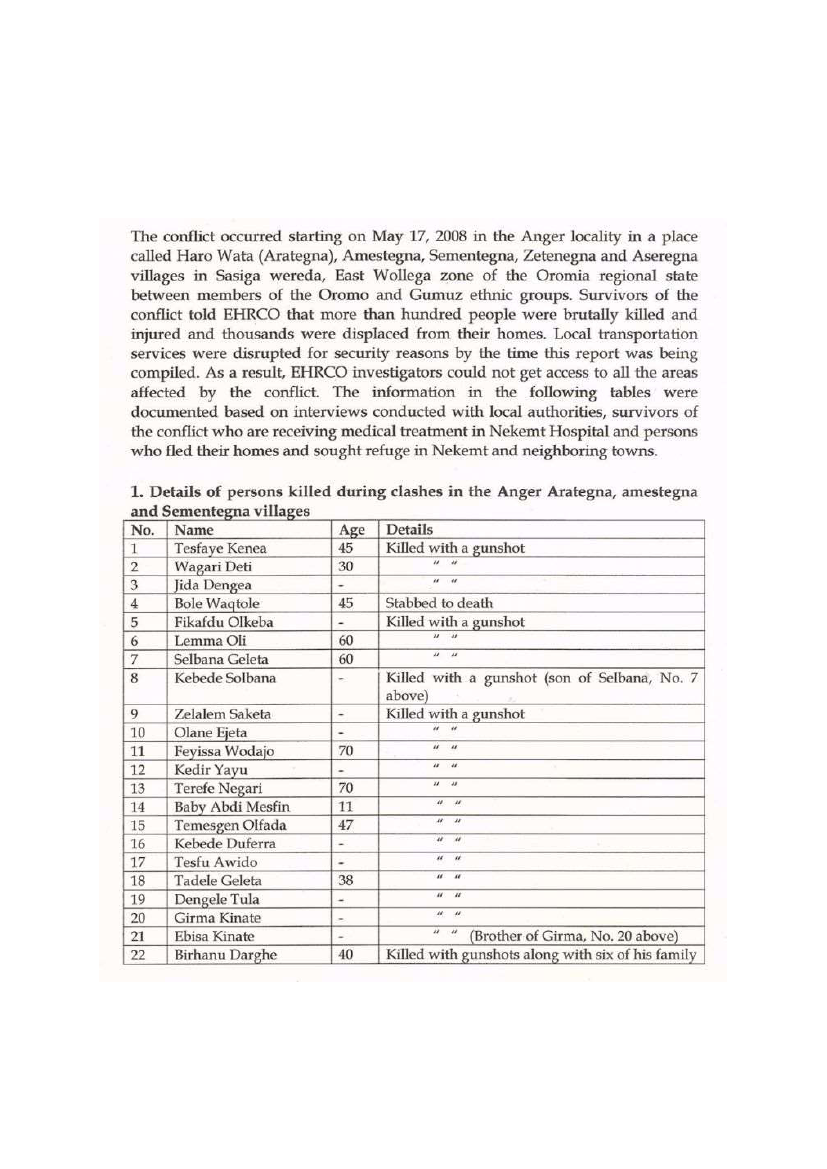
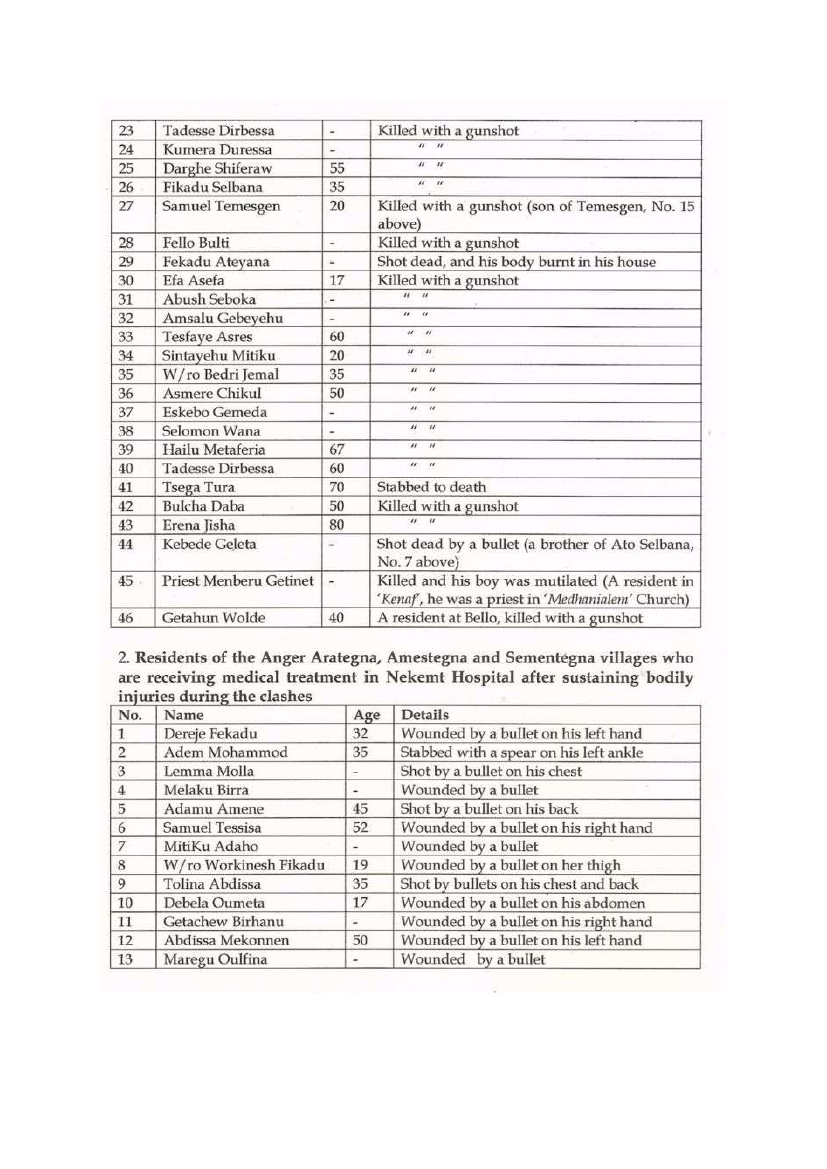
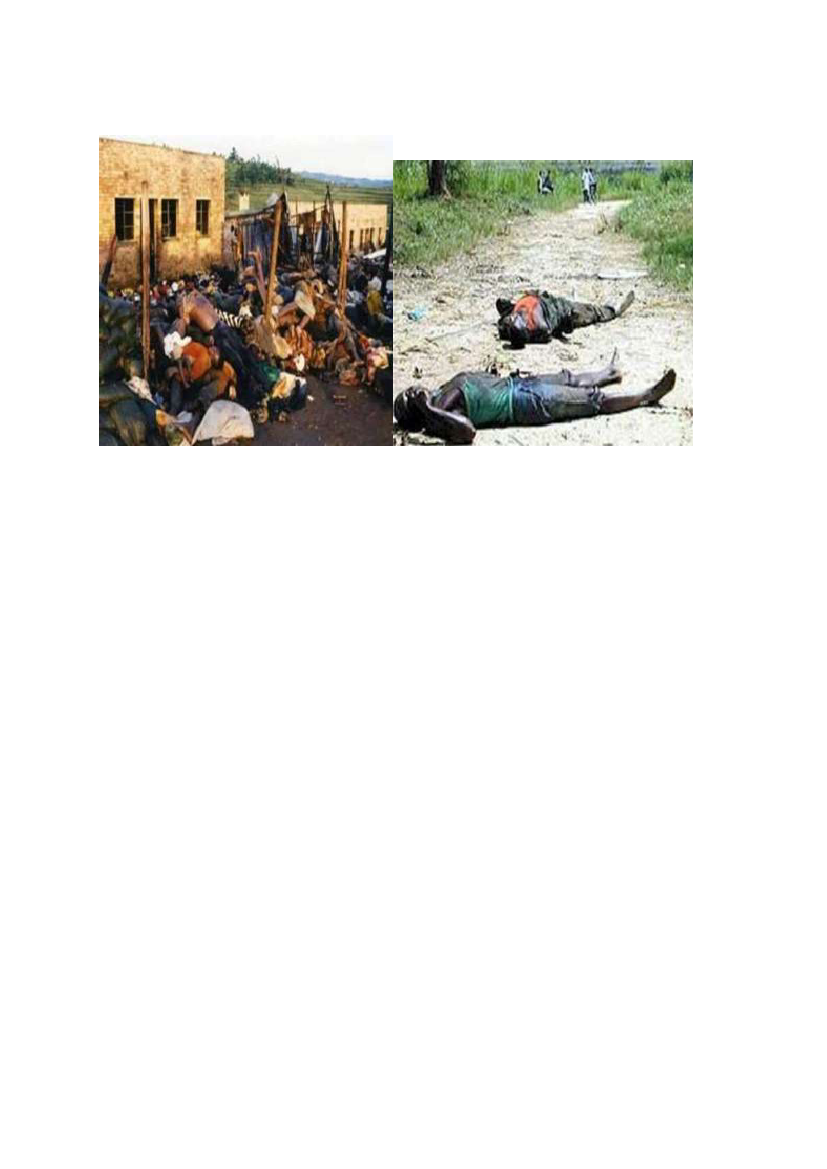

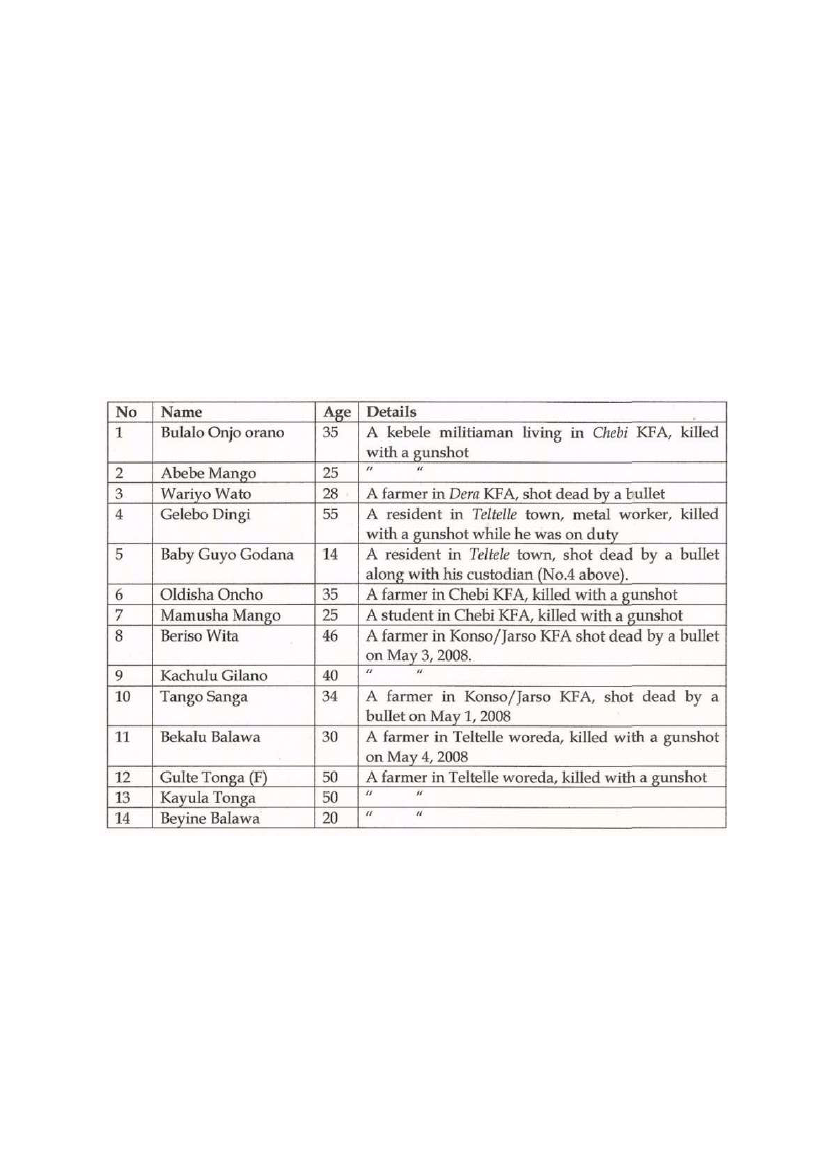
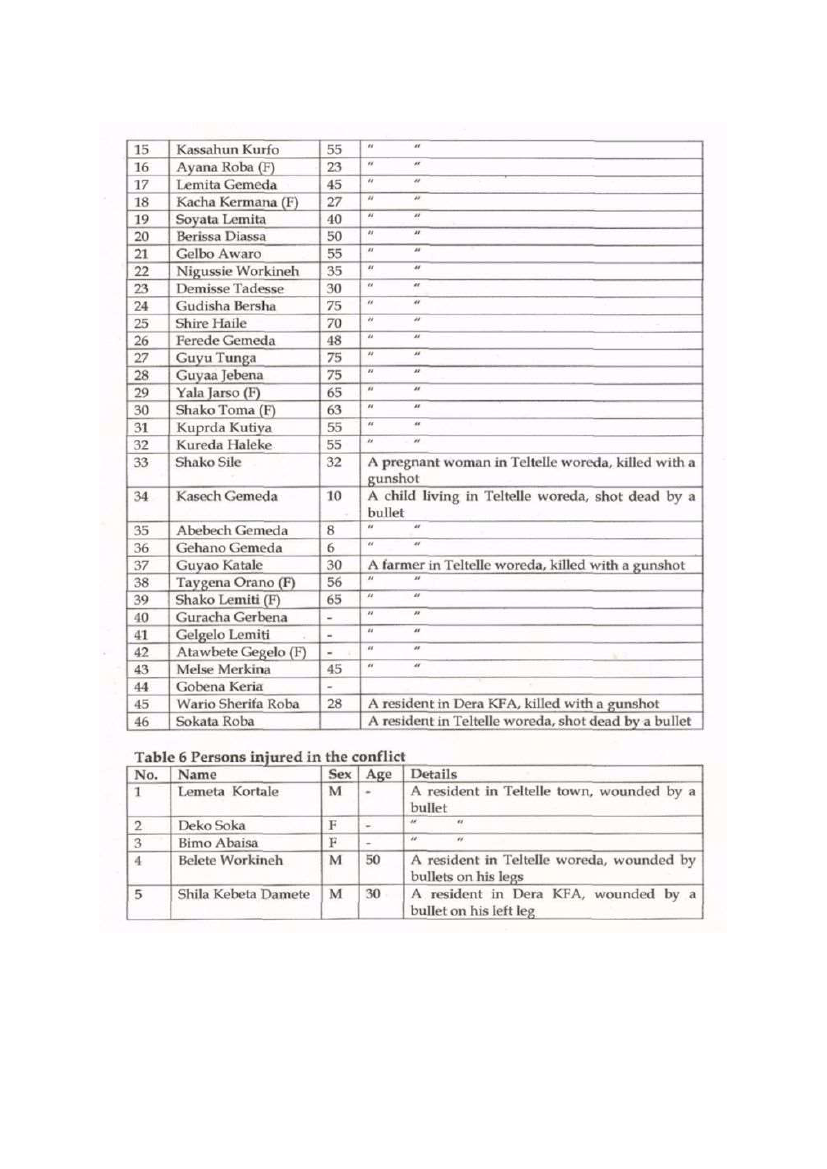
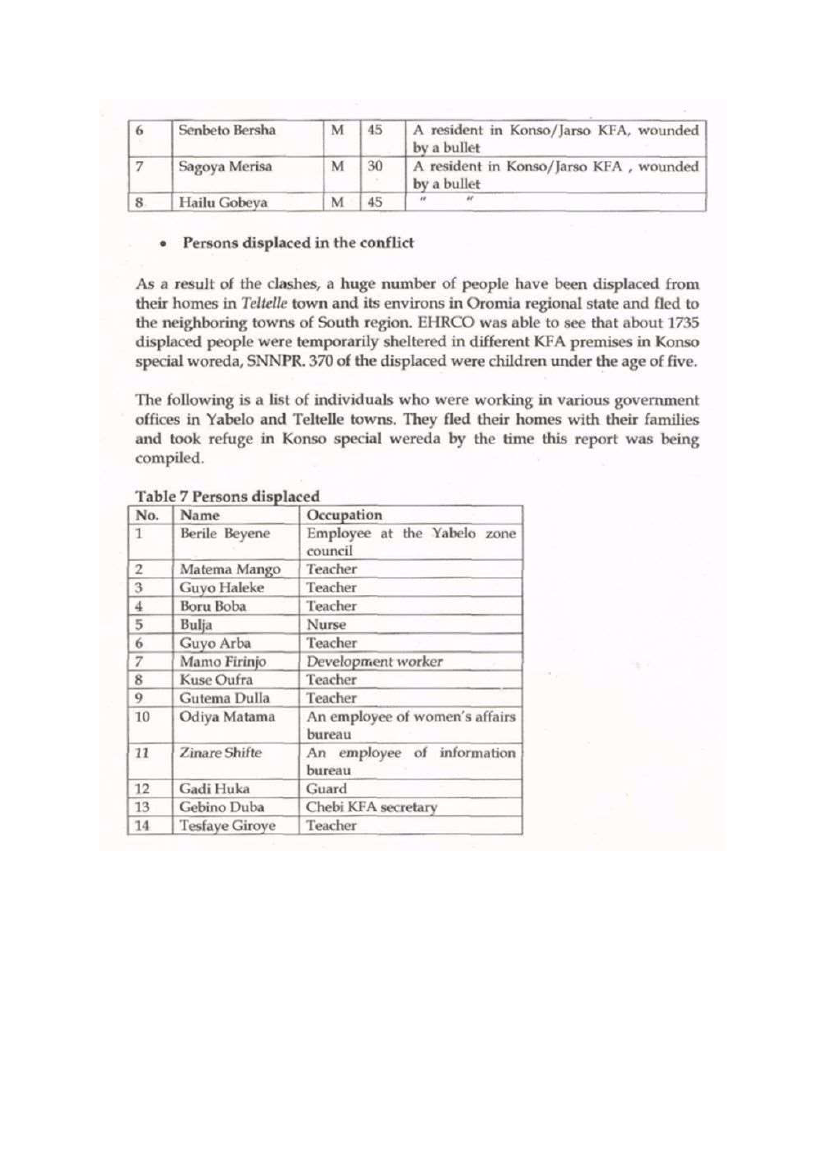
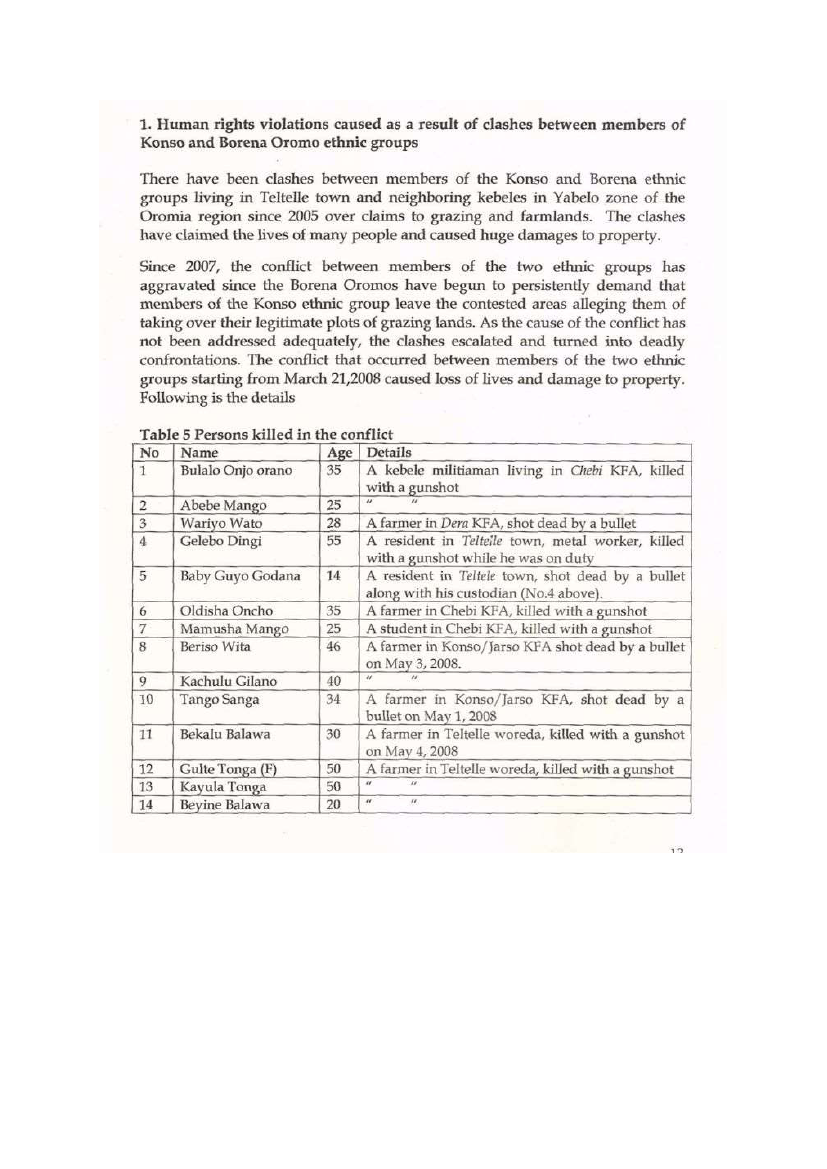
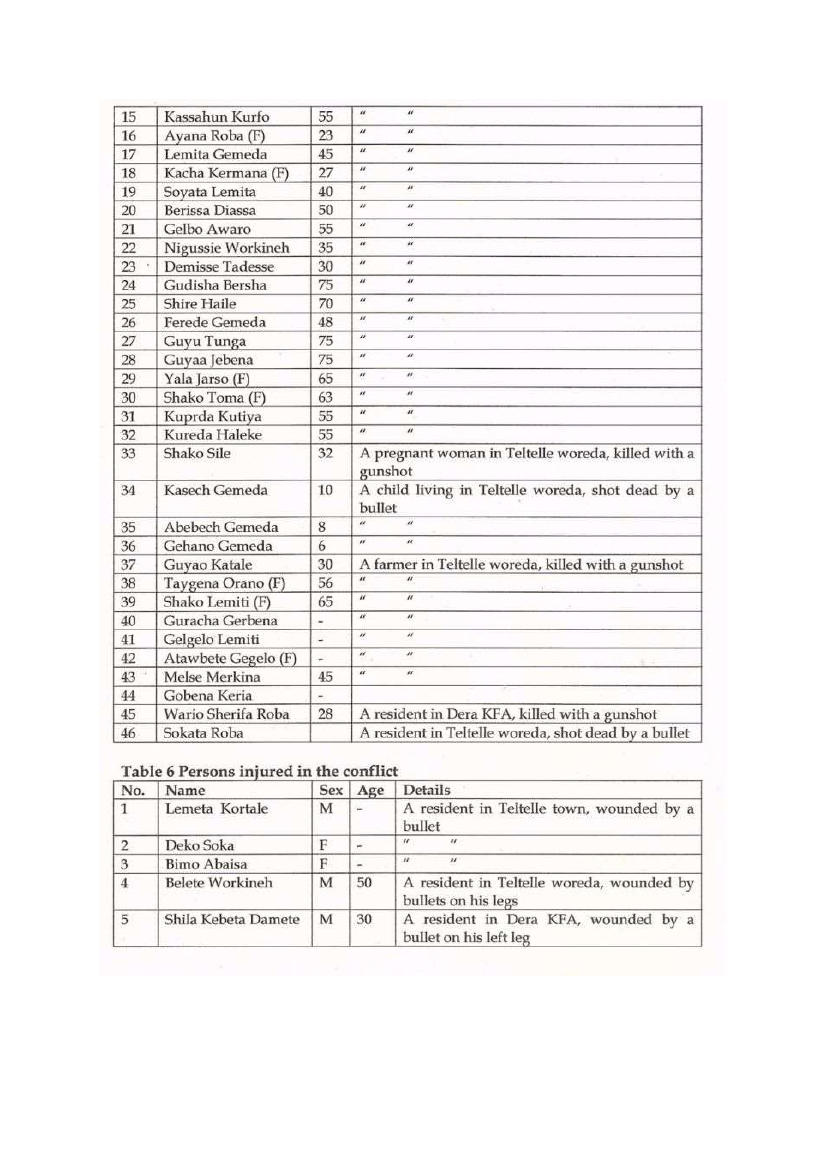




PARTIAL LIST OF OROMOS KILLED UNDER THE OUTBRUST OF EPRDFGOVERNMENT INISTIGATED ETHNIC CONFLICTThe TPLF regime’s track record of the past 22 years of rule is full of intriguesthat instigated bloody conflicts among nation and nationalities in Ethiopia .As a result of TPLF’s machinations Oromo and Sidama, Oromo and Somali,Oromo and Gedao, Anywak and Nuer, Oromo and Amhara, Oromo andOromo, Oromo and Gumuz and several other people have clashed. As aresult thousands of innocent lives were lost, tens of thousands of peoplewere displaced and their houses and properties were destroyed.The most causes of the conflicts were inequitable distributions of economicand political power or the demand for access to political and economicbenefits. Furthermore, almost all of the major conflicts were not based onethnic antagonisms. Yet, they were labelled as ‘inter-ethnic conflicts’ simplydue to the fact that they bear the names of the participant ethnic groups.Above all, the conflicts are the results of government induced divide and rulepolicy.Article 3 of the Universal Declaration of Human Rights (UDHR), whichEthiopia has endorsed, provides “Everyone has the right to life, liberty andsecurity of person.” Article 6(1) and 9(1) of the International Covenant onCivil and Political Rights (ICCPR), to which Ethiopia is a party, recognizethese basic rights, and stipulate in its Article 2(1) (2) that states parties havean obligation to respect and protect these rights in their respectiveterritories. Moreover, Article 14 of the Constitution of the FederalDemocratic Republic of Ethiopia (FDRE) provides, “Every person has theinviolable and inalienable right to life, the security of person and liberty.”However, these fundamental human rights are being violated due to thisgovernment instigated ethnic clashes that resulted serious human rightsviolations and damages caused to public and private property.OLF Information and Research Unit has outlined below some of the conflictsthat have caused of life and property mainly targeted on oromo people are:-
1. The Oromo and Gumuz ConflictThe Oromo and Gumuz peoples have lived together as good neighbors forcenturies. They are culturally intermingled and share valuable social,political and economic set-ups. But ever since it came to power, theTPLF/EPRDF regime has applied the outdated ‘divide and rule’ policy to1
weaken peoples’ struggles for freedom and justice by sowing seeds ofdisharmony among friendly neighboring peoples.
I)
March 4, 2013
At least 20 people died this weekend in an outburst of violent ethnic clasheson the border of the Benishangul region and the region of Wallagaa, Oromia,in West of Ethiopia: armed militia of the Gumuz ethnic group have beenattacking and killing unarmed Oromo civilians. Although the Ethiopiangovernment has deployed its police forces, they remain witness to the ragingkillings, instead of stopping the killers.The ongoing armed attacks started last Monday night in the Manasibudistrict, according to different independent sources in the field. Conflictshave been reported in Odaa, Daleti, Fadun Fardosi, Gunfi, and Badessa,forcing thousands of Oromo families to flee their homes.
II)September 2011September 22, 23 and 24 2011 heavly armed Gumuz milsha openend gunfire onoromos living Eebantuu Ganda Lalisaa Dhangaggoo, Ona Mootii, Qilxuu Sanyii,Axabballaa,Yuubdoo fi Bakka Qonnaa Balaccu jedhamutti lolli kun Guyyaa sadiifmeeshaa hammayyaa fi humna hidhannoo guutuu hidhateen Mootummaanwayyaanee qindeessee ummata Oromoo irratti Gosa Gumuz meeshaa hangafunyaaniitti hidhachiisee, Oromota meeshaa maleeyyii Qotee bulaa, maanguddoo fi Ijoollee irratti bobaasee qee jireenya isaanii keessaatti ficisiise.A.killed,1.Mr Maatabuu Xiixaa with family member of 152.Mr. Nigaatuu Dabbis with family member of 14.3. Mr. Abdannaa Darajjee with family member of 074.Mr. Fiqaaduu Hundumaa with family member of 065. Mr. Tafarii Adimaasuu with family member of 056.Mr. Dassaalee Ittafaa with family member of 047.Mr Magarsaa Guddaataa studnt 12B.Wounded1. Mr. Gabbisaa Kasasaa2.Mr. Asaffaa Gabbisaa3.Mr. Abbabaa Malataa4.Mr. Abdiisaa Abbabaa5.Mr. Fiqiruu Dhaabaa6. Mr Yaaragaal.Almost about 1,500-2,000 peoples were displaced.III)May 2008The outburst of ethnic violence claimed the lives of more than 400 Oromopeople. The Gumuz militia attack on the unarmed civilian Oromos causedthe death of hundreds and many more injuries and displacement of2
hundreds to people, and destruction of houses and properties. Hundreds ofOromos were subjected to horrific and barbaric killings. The militia is said tobe so heavily armed that the local police themselves had to flee along withthe civilians. The relevant government body and armed forces werebystanders watching the massacre of the unarmed and defenseless Oromos.
3
4
A pile of corpse after horrific killings
2. The Oromo and Ethnic Somali ConflictI)June 2000
At least 70 Oromos were killed in Eastern Oromia during the armed conflictthat ensued between Oromos and Issa Somalis, according to a press releaseissued on June 30, 2000 by the National Council of the Oromo LiberationFront. Eyewitnesses contacted by say thousands of Oromos around Meiso,Asabot, Dema and Diddimtu are fleeing the area and the situation is verytense. The OLF communiqué accuses the TPLF government of instigating theviolent conflict and taking side by arming the Issas and supplying them withammunition while at the same time disarming the Oromo victims.
II)
September 1994
The cry of the Dollo Manna Oromos (BALE) 17 indigenous Oromo villages,which were originally assigned to region 4 have been reassigned to theOgaden Somali region (Region 5) by the EPRDF and the Ethiopian SomaliDemocratic League(ESDL) without regard to the opinions and indigenousrights of the Oromo living there. The following information is a roughtranslation of the appeal these Oromos made to the government. TheOromos indicated that areas of Madda Walaabuu, the cradle of the Oromoland, the dire Sheik Hussein area; and the Sof Omar area were put underthe Somali regional administration, thus violating the charter-based rights5
of the Oromo people. And they further indicated that the intention behindthis annexation is to create conflict and to destroy the historical right of theOromo to this land, to its rich culture and to the vast human and naturalresources on this land. Backed by the EPRDF army, the ESDL openedoffices and hoisted the ESDL flag and began to harass the Oromo in the Baleregion in relation to their economic, social, and political rights. The ESDLcontinued preaching its divisive policies by saying that the Somali Gree orBeed clan, the somali Baha (east) clan, the Somali Dhiha (west) clan, andthe Somali Aabboo clan belong in specific places on this land. Thesesentiments are intended to eradicate Oromo identity, culture and history soas to help the EPRDF to deny the Oromo self-determination in their owngeographical localities. The EPRDF army and its security forces headed bytheir commander Wadu Gay have also stood by the ESDL to annex theabove mentioned areas, as well as the Rayitu, Dawee and Girira areas intothe ESDL region, by using force of arms. That has let a lot of Oromo bloodand caused illegal detention, killings and unabated harassment. The Oromopeople's appeal indicates that the application that was sent to the OPDO didnot produce any result. So the Oromo people said that these violations ofOromo rights and looting of property were ordered from above. It remainsthe responsibility of the Council of Representatives to resolve this conflictwithin the shortest possible time. Whatever the consequences are the follow,due to the reluctance of the Council to resolve this conflict, the loss of livesand destruction of property will be the historical responsibility of theCouncil itself, not just that of the ESDL and the National Defence Force.These Oromo people said that the people of their area have been shocked bythe actions of the EPRDF army in the presence of the free court and thepolice. The signature of several representatives of the Oromo peopleconclude the appeal, Copies were directed to the Council of Ministers, theCouncil of Representatives, the Ministry of Internal Affairs and AmnestyInternational in London.
3) The Boranaa and Konso ConflictI) March 2008Following is a record of human rights violations caused as a result of theclashes that occurred between members of the Borena Oromo and Konsoethnic groups in Teltelle wereda of the Oromia region and between membersof the Oromo and Gumuz ethnic groups in the areas bordering the Oromiaand Benishangul Gumuz regions.There have been clashes between members of the Konso and Borena ethnicgroups living in Teltelle town and neighboring kebeles in Yabelo zone of theOromia region since 2005 over claims to grazing and farmlands. The
6
clashes have claimed the lives of many people and caused huge damages toproperty.Since 2007, the conflict between members of the two ethnic groups hasaggravated since the Borena Oromos have begun to persistently demandthat members of the Konso ethnic group leave the contested areas allegingthem of taking over their legitimate plots of grazing lands. As the cause ofthe conflict has not been addressed adequately, the clashes escalated andturned into deadly confrontations. The conflict that occurred betweenmembers of the two ethnic groups starting from March 21,2008 caused lossof lives and damage to property. Following is the details (EHRCO 31 regreport)Persons killed in the Conflict
7
8
9
10
11
12
4.Gujii and BurjiiThe Guji and Burji ethnic groups, which share common boarders with theOromia Regional State and SNNPRS, have long lived in harmony andpeaceful co-existence. However, since recently, as their quest for land claimhas not been resolved, they have often come into conflicts resulting in severehuman and property damages.The human causalities and property damages incurred during conflictsbetween the two ethnic groups in Haro Bule locality, Galaba Kebele, Areroworeda, Borena zone of the Oromia regional state, on February 27, 2007,from 2:00 p.m. till 5:00 p.m. Owing to the aforementioned inter-ethnicconflict, the following people have been killed.NoName1. Gobena Anole2Duba Godana NenkoAge3025Occupationpastorialistpastorialist
B. Gunshot WoundsIndividuals whose name listed below have sustained heavy and light injuriesdue to the conflict:1.2.3.4.5.6.7.8.Gararo Bati FecheGayo Bati FecheSora DodaJarso GefersaDulo WaritoGelgelo GudanaKonchera HukaWariyu Kontobo
5. Ethic conflict sparked in Sokoru Woreda, Jimma Zone, OromiaregionArticle 39(1)(2) of the FRDRE Constitution stipulates that Every Nation,Nationality and People in Ethiopia has the right to self-determination, and todevelop and promote its own culture, language, among others. Accordingly,Yem nationals who reside in Sokuru town and neighboring Kebeles in itsenvirons, Jimma Zone of the Oromia regional state, have requested to be13
administered by the Yem special woreda of the South Nation, Nationalities,and People’s Regional State (SNNPRS) as of 1993.In reply to the request, a study committee drawn from the Oromia RegionalState and SNNPRS had been organized, and based to the findings of thecommittee a referendum was held on November 27, 2007 in which themajority voted in favor of administration of the woreda under SNNPRS.However, the result of the referendum has not yet been implemented.Because of this, ethnic conflicts have often flared up, resulting in deaths,human causalities, property damages and security problems.On November 3, 2006, at 6:00 p.m., over 100 armed security forces enteredthe Yem nationals Sokoru woreda, Kebele 01 administration, and detainedthe people they found, and said,”You will fall under our administration as oftoday.” When families of the detainees who heard the news, brought dinnerfor them at 9:00 a.m., there were prevented by the armed men. This time,conflict broke out between the residing Yem nationals and the armedmembers of Oromo nationals. The clash raged through the night causingphysical injuries and property damages. The conflict has subsided and wasbrought under control the next day, as members of the Federal police andarmy reached the area.EHRCO has investigated and verified the following human causalitiesand property damages.A. KillingMr. Zinabu Abafogi Aba Wari: He was a resident of Wengesho kebele,on November 4, 2006, he was shot to death by a bullet fired byunidentified armed man.B. Gunshot wounds1. Tesfaye Shege: He is a resident in Sokoru Woreda, Kebele 01. He isa guard. He was wounded by a bullet on the leg.2. Ageritu Wondimu: She is the Sokoru Woreda, Kebele 01 resident,and is a preparatory student at a secondary school. She sufferedbullet wound on the leg, and is now under medical care at the WolisoHospital.3. Alemnesh Belaineh: She is the Sokoru Woreda, Kebele 01 resident.She was wounded by a bullet on the leg, and received medications atthe Woliso Hospital.4. Asnakech Weranko: She is a resident in Sokoru woreda, Kebele 01.She was wounded by a bullet and received medical care at the WolisoHospital14
6. Gujii-Sidama ConflictIt is to be recalled that although members of the Guji ethnic group living inWendogenet Woreda, Sidama Zone of the SNNPR petitioned regionalauthorities since 1993 and subsequently the House of Federation to begranted a self-administration status, their request has not been adequatelyaddressed. As a result, an ethnic conflict had flared up between members ofthe Guji and Sidama ethnic groups on 16 May 2007. In connection withthis, 82 individuals belonging to the Guji ethnic group were arrested withouta court warrant and were subsequently released. The following humanrights violations occurred during the conflict on May 16, 2007.KillingsThe following individuals belonging to the Guji ethnic group were shotdead during the conflict.1. Neko Nenko: 362. Markos Katiso: 403. Tsefaye Mengistu: 224. Mitiku Lemma: 34
15















